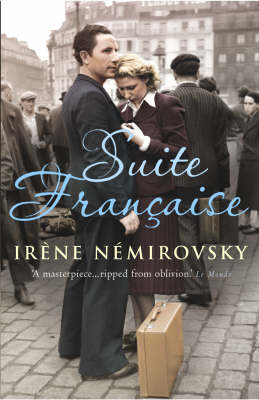
Suite Francaise
Seiten
2006
Chatto & Windus (Verlag)
978-0-7011-7993-9 (ISBN)
Chatto & Windus (Verlag)
978-0-7011-7993-9 (ISBN)
- Titel ist leider vergriffen;
keine Neuauflage - Artikel merken
She did not live to see her ambition fulfilled, or to know that sixty-five years later, Suite Française would be published for the first time, and hailed as a masterpiece Set during a year that begins with France's fall to the Nazis in June 1940 and ends with Germany turning its attention to Russia, Suite Française falls into two parts.
In 1941, Irène Némirovsky sat down to write a book that would convey the magnitude of what she was living through, not in terms of battles and politicians, but by evoking the domestic lives and personal trials of the ordinary citizens of France. She did not live to see her ambition fulfilled, or to know that sixty-five years later, Suite Française would be published for the first time, and hailed as a masterpiece
Set during a year that begins with France's fall to the Nazis in June 1940 and ends with Germany turning its attention to Russia, Suite Française falls into two parts. The first is a brilliant depiction of a group of Parisians as they flee the Nazi invasion and make their way through the chaos of France; the second follows the inhabitants of a small rural community under occupation who find themselves thrown together in ways they never expected. Némirovsky's brilliance as a writer lay in her portrayal of people, and this is a novel that teems with wonderful characters, each more vivid than the next. Haughty aristocrats, bourgeois bankers and snobbish aesthetes rub shoulders with uncouth workers and bolshy farmers. Women variously resist or succumb to the charms of German soldiers. However, amidst the mess of defeat, and all the hypocrisy and compromise, there is hope. True nobility and love exist, but often in surprising places.
Irene Némirovsky conceived of Suite Française as a four- or five-part novel. It was to be a symphony - her War and Peace. Although only two sections were finished before her tragic death, they form a book that is beautifully complete in itself, and awe-inspiring in its understanding of humanity.
In 1941, Irène Némirovsky sat down to write a book that would convey the magnitude of what she was living through, not in terms of battles and politicians, but by evoking the domestic lives and personal trials of the ordinary citizens of France. She did not live to see her ambition fulfilled, or to know that sixty-five years later, Suite Française would be published for the first time, and hailed as a masterpiece
Set during a year that begins with France's fall to the Nazis in June 1940 and ends with Germany turning its attention to Russia, Suite Française falls into two parts. The first is a brilliant depiction of a group of Parisians as they flee the Nazi invasion and make their way through the chaos of France; the second follows the inhabitants of a small rural community under occupation who find themselves thrown together in ways they never expected. Némirovsky's brilliance as a writer lay in her portrayal of people, and this is a novel that teems with wonderful characters, each more vivid than the next. Haughty aristocrats, bourgeois bankers and snobbish aesthetes rub shoulders with uncouth workers and bolshy farmers. Women variously resist or succumb to the charms of German soldiers. However, amidst the mess of defeat, and all the hypocrisy and compromise, there is hope. True nobility and love exist, but often in surprising places.
Irene Némirovsky conceived of Suite Française as a four- or five-part novel. It was to be a symphony - her War and Peace. Although only two sections were finished before her tragic death, they form a book that is beautifully complete in itself, and awe-inspiring in its understanding of humanity.
Irène Némirovsky was born in Kiev in 1903, the daughter of a successful Jewish banker. In 1918 her family fled the Russian Revolution for France where she became a bestselling novelist . She was prevented from publishing when the Germans occupied France and moved with her husband and two small daughters from Paris to the safety of the small village of Issy-l'Evêque (in German occupied territory). It was here that Irène began writing Suite Française. She died in Auschwitz in 1942. Translated by Sandra Smith.
| Erscheint lt. Verlag | 2.3.2006 |
|---|---|
| Übersetzer | Sandra Smith |
| Verlagsort | London |
| Sprache | englisch |
| Maße | 152 x 233 mm |
| Gewicht | 545 g |
| Themenwelt | Literatur ► Romane / Erzählungen |
| Literatur ► Zweisprachige Ausgaben ► Deutsch / Englisch | |
| ISBN-10 | 0-7011-7993-7 / 0701179937 |
| ISBN-13 | 978-0-7011-7993-9 / 9780701179939 |
| Zustand | Neuware |
| Haben Sie eine Frage zum Produkt? |
Mehr entdecken
aus dem Bereich
aus dem Bereich
Zweisprachige Ausgabe (deutsch/englisch) / Parallel gesetzter Text …
Buch | Softcover (2024)
Anaconda Verlag
CHF 9,75
Buch | Softcover (2024)
dtv Verlagsgesellschaft
CHF 18,20


